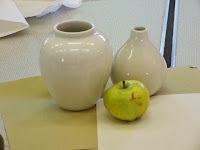In this term we are doing a further exploration into the relationship between music and art, we hope to discover what mood we can translate to our viewer through our choice of colour and application.
So we looked at images along with various pieces of music, some sad, some dramatic, and some light and still, and we reflected on our response to each image as we made group decisions of which painting we would associate with each image, the choices were on the whole unanimous, concluding that dark blue and neutral images correlated with music which was still and somber
Whereas dramatic music related to bright intense paintings with a lot going on as a generalisation
And lively music to visual expressions with vigorous line work of brush marks
Look at these images and see what your response is.
Next we had an exercise in choosing photocopied images of paintings associated with different music.
Then we did an exercise in recognising the intrinsic tonal value in pure colour, and colour diluted.
See below
Then we started working on a photograph I took on our Flatford Mill painting holiday, we made the colour choice to use only the top light light section of our value-colour wheel, but before that we had a look at the differenc a new colour bias had to the mood of the image.
The image below was for the less experienced in the group, as I had already de- saturated the photo in colour, and lightened it tonally so they only had to copy what was there in preperation for making their own colour choices from something less obvioius
We will continue these next week
OUR VISIT TO THE BOTANIC GARDENS WILL BE ON WED 23RD AND THURSDAY 24TH OCTOBER.


































